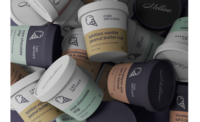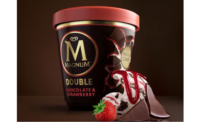Ice Cream Cones,Hot Dog Casings and Other Edible Packages
Ice Cream Cones,Hot Dog Casings and Other Edible Packages
By Aaron Brody
Food in hand, today’s busy consumer bites, munches, licks, chews and multi-tasks—in the car, on the street and in the office. Sometimes the food is wrapped, and sometimes the food and its package are one: the ice cream cone and the hot dog casing, for example.
Edible packaging might make economic and technical sense when it is combined with conventional package materials in ways that reduce package mass, simplify packaging and lower costs. Biodegradable and photodegradable packaging can also be a way to ensure that our planetary bounty is preserved.
Coatings
Edible waxes, polishes, shellac, sugar, salt, and analogs have long been used to enhance moisture, oxygen or flavor gains or losses.
But such coatings are not generally intended to replace non-edible packaging. Instead they provide a level of protection that may reduce the complexity, specification—and cost—of conventional packaging, which is still indispensable.
Edible films
Most current research on edible films addresses new materials with improved properties that may have the potential to incorporate antimicrobials, antioxidants, flavors and nutrients into a product.
Biodegradable and photodegradable materials
Biodegradable package materials are engineered to break down after they have performed their basic function. But safety issues and issues related to the activation of the biodegradation process and the disposition of end products have not yet been resolved.
Photodegradable packaging decomposes into its constituent elements when it is exposed to visible and/or ultraviolet radiation. But photodegradable thermoplastic sheets and film have not yet met the dual criteria of functionality and degradability in a timely manner.
Applications
Commercially available water-soluble pouches (derived from polysaccharides) have been valued for years for their superior oxygen barriers. And collagen has been a major sausage casing for decades, but its progress in other areas has been limited—perhaps because of its marginal sensory characteristics.
More recently, other organic materials, such as whey protein, have been extruded into transparent films that can be converted into pouches.
One major objective of research today is to develop new materials into edible films and coatings that offer properties that would permit manufacturers to reduce their reliance on “traditional” thermoplastic structures, or at least, reduce the quantities they require. With the cost of hydrocarbon resources soaring, the notion of renewable resources is intriguing.
It is evident that universities performing research have a teaching tool that can translate edible film packaging concepts into mainstream packaging solutions. Are the objectives of edible films and coatings sufficient to warrant the investment? Should industry and government redouble their efforts, since we are so close to breakthroughs in edible films? Or is it best to attempt the crossover—the marriage of thermoplastics and edible materials for better packaging? BP
The author, Aaron L. Brody, Ph.D., is President/CEO of Packaging/Brody Inc., a consultancy in food, packaging technology and marketing.
Contact Dr. Brody at 770.613.0991 or aaronbrody@aol.com
Contact Dr. Brody at 770.613.0991 or aaronbrody@aol.com
Looking for a reprint of this article?
From high-res PDFs to custom plaques, order your copy today!






